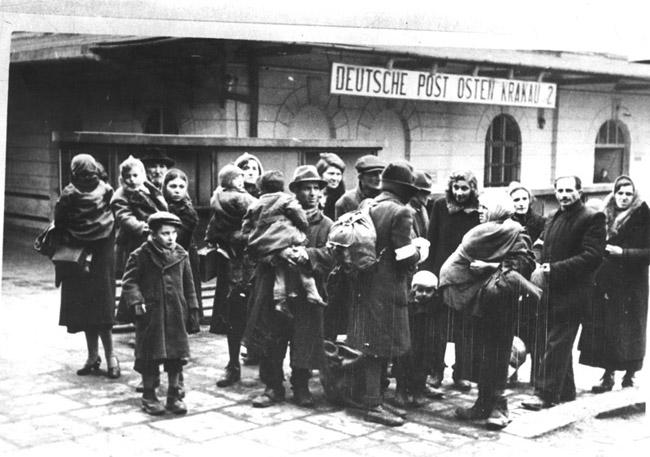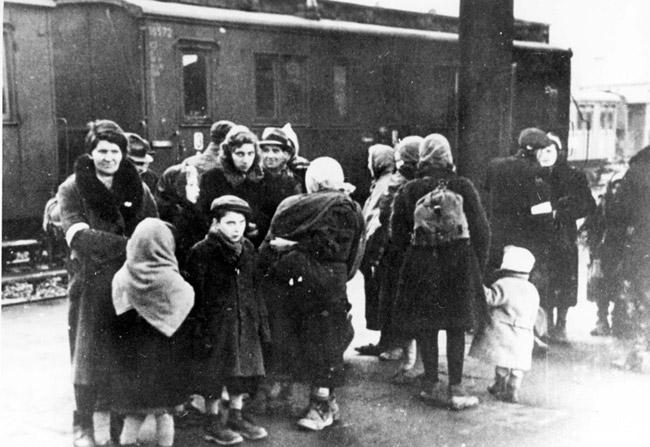Around 3.3 million Jews lived in Poland at the outbreak World War II. Germany invaded Poland on 1 September 1939 and according to a pact signed shortly before, the country was divided between the Soviet Union and Nazi Germany. Poland's western territories were annexed by Germany and the Generalgouvernement was created in the remaining part under its control. About 1.2 million Polish Jews came under Soviet rule until the summer of 1941, when Germany attacked the Soviet Union and conquered the rest of former Poland.
Anti-Jewish measures were enacted immediately after the German occupation in 1939: Jews were ordered to wear an armband with a Jewish star; their property was seized; they were taken for forced labor; their movement was restricted; and ghettoes were established, most of which were sealed between 1941-1942, where the Jews were mostly doomed to a gradual death, from hunger, cold and infectious diseases.
In December 1941 the first extermination camp, Chelmno began operating on Polish soil. During the spring of 1942 three more camps were added – Sobibor, Belzec and Treblinka – as part of Operation Reinhard – the program for the liquidation of Polish Jewry. The Concentration camps of Majdanek and Auschwitz were expanded to function as killing centers. By the end of 1942 a large majority of Poland’s Jews had been killed. The liquidation of the ghettos continued, and with the exception of the Lodz ghetto, which was liquidated in summer 1944, the only Jews left in Poland were in labor camps.
It is estimated that 3 million Polish Jews – 90% of the pre-war community – perished in the Holocaust.
* * *
Between the two world wars the renewed Polish state was challenged with large national and ethnic minorities that amounted to about a third of the population. The Polish national camp generally defined the Jews as an alien ethnic and religious element. Although among certain Polish intelligentsia and liberal circles there was a tendency to integrate the Jews, the masses of Jews continued to live in separation in their own neighborhoods and generally were not favorably regarded by the surrounding population. In the second half of the 1930's antisemitic fervor reached new heights.
After the conquest of Poland, Poles and Jews fell victim to Nazi Germany's regime of terror. However while the policy directed against Poles was intended to turn them into slaves, the Jews were targeted first for overall isolation, and later for total liquidation.
Facing a ruthless occupation and being engaged in a constant struggle for existence, the Polish public at large paid little attention to the immensely greater distress of those interned behind walls and fences. Only some cases of ongoing personal or political friendship between Poles and Jews endured. Individual Poles, motivated by humanitarian reasons, tried to ease the grievous predicament of the Jews and help them escape. In order to leave the ghetto with some chance of rescue, it was not enough for a Jew to be prepared to cut himself off from his surroundings and to go to an unknown destination. As a first step, he had to have a reliable Polish address and a positive response from its inhabitants, as well as money or valuables to cover his living expenses, and in many cases also ransom money in case the war lasted a long time.
A Pole caught hiding Jews endangered his own life and that of his family. And indeed, hundreds of Poles paid with their lives for such deeds. The German threat was constant and they were always hunting for Jews, assisted by the Polish "blue police". However, what prevented Jews from leaving the ghetto and moving freely through the cities and villages was also the fear of some Poles – the “szmalcowniks” – who would inform on them, hand them over to the Germans, or extort all their property from them. These informers were propelled by the corrupting regime that spread hatred and the cheapness of human life in the eyes of the occupier, as well as by antisemitism that had always been rife in parts of Polish society and played a role in the intensity of the widespread malevolence. The threat of denunciation not only deterred Jews from attempting to find shelter among Poles, but also forestalled Poles of good will who feared neighbors or even relatives who were likely to endanger them. Only in September 1943 did the underground leadership announce that a sentence was meted out to someone for blackmailing, robbing and handing over Jews.
While the extent of Polish national solidarity directed against the German occupier was impressive, the Jews were never included in it. It is indeed true that along with passivity and malice, the physical annihilation and the dimensions of the tragedy of the Jews caused some avowed antisemites to cast aside their hostility and lend a helping hand to Jews. Small groups of people, such as employees in the social aid department of the Warsaw municipality and former members of a Polish Catholic Scouts movement, acted with great courage and devotion.
The mass deportation of Jews in summer 1942 caused shock to some groups of Poles. The first who were galvanized into calling for an organized act of rescue and who condemned the public’s uncaring passivity, were Catholics, mostly young men, members of the “Revival of Poland Front” underground.
In early in December 1942, Zegota – the permanent Council of Aid to Jews – was founded. Zegota was engaged in finding housing and hiding places, the distribution of a monthly allowance, care of children, medical help, providing false documents, etc. Though most of Poland's Jews had been murdered by the time of Zegota's establishment, it is estimated that it rescued several thousand Jews. In addition to the organized attempts, many Righteous Among the Nations who risked their lives acted without any connection to Zegota, perhaps even without knowing of its existence. These men and women embarked on the rescue endeavor, urged by an inner voice that told them to help the suffering and the oppressed, and their deeds often resulted from past favorable experiences or friendships with Jews.
The Polish underground's attitude during the ghetto period was marked by lack of interest in the fate of the Jewish citizens of Poland. They provided neither material nor moral help to the Jews. During Warsaw ghetto uprising besides some scant assistance with arms, no protection, military assistance or help was given to Jews by the Polish underground Home Army (AK).
* * *
Poles constitute the largest national group within the Righteous Among the Nations recognized by Yad Vashem. Considering the harsh punishment that threatened rescuers, this is a most impressive number. On the other hand, when evaluating the role of Poles in the rescue of Jews, one also has to take into consideration that Poland's Jewish community was by far the largest in Europe and that only about 10% of it's Jews survived. At liberation, around 50,000 Jewish survivors were on Polish soil. It is estimated that about 30,000 to 35,000 Jews, around one percent of all of Polish Jewry, were saved with the help of Poles and thanks to the devotion of Righteous Among the Nations.


